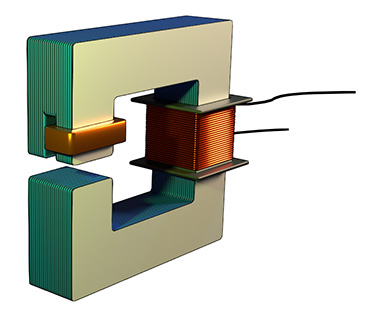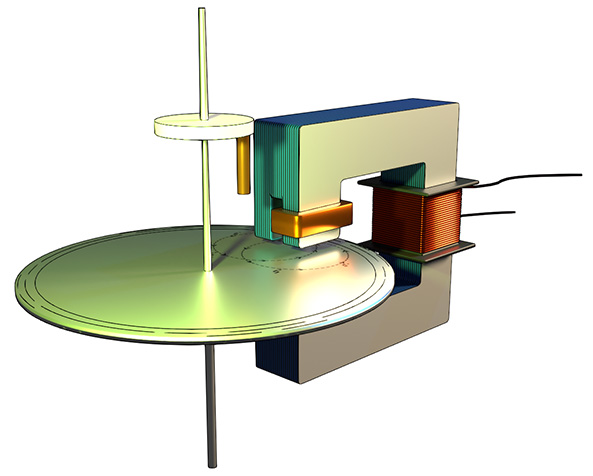An induction disk relay is a variety of electromagnetic relays. It belongs to one of the most primitive forms of conventional electromechanical protection relays. Its basic construction and working principle are quite simple.
Basic Construction of Induction Disk Relay
There is an electromagnet. The system current or a current proportional to the system current flows directly through the coil of the magnet. As a result, the alternating current flowing through the coil produces alternatingly changing magnetic flux in the core of the electromagnet.

We specially design the core of the magnet to split the flux into two parts. Essentially, one limb of the magnetic core is divided into two poles. These two poles split the flux.
Splitting of Flux
One of the poles of the magnetic core is covered with a copper ring. We sometimes refer to it as a shading ring. Therefore, this pole is referred to as the shaded pole. When magnetic flux passes through the shaded pole, it induces a circulating current in the copper ring. This current produces a counterflux in the pole. Obviously, that flux opposes the main flux through that pole. Therefore, the main flux through the shaded pole lags behind the flux of the unshaded pole. As a result, it creates a phase difference between the flux of the shaded and the unsheathed pole.
Aluminum Disc
Then we place a circular lightweight aluminum disc between the faces of the electromagnet. The edges of the disc intercept the fluxes from both the shaded and unshaded poles. Since both fluxes are alternatingly changing in nature, they induce their respective eddy currents in the disk.

The eddy current produced by the unshaded pole interacts with the flux of the shaded pole. On the other hand, the eddy current produced by the shaded pole interacts with the flux of the unshaded pole. As a result of these interactions between the eddy currents and the magnetic fluxes, mechanical forces are produced on the disc on both sides. By applying Fleming’s Left-Hand Rule, we can determine the direction of these forces. The resultant force creates a torque that rotates the disk about its central spindle and bearings.
Restoring Force in Induction Disk Relay
A flat spiral spring attached to the spindle provides the necessary restoring force. When the disk rotates due to torque, the spring deforms and opposes the rotation. This restoring force prevents disk rotation under normal current conditions.

When the current exceeds a threshold value, the torque acting on the disk overwrites the restoring force, causing the disk to rotate. The spindle holds a moving contact, allowing it to rotate along with the disk. After a certain angle of rotation, the moving contact makes contact with the fixed contact, thereby closing the normally open (NO) contact.
Damping in Induction Disk Relay
Damping is provided using a permanent magnet. As the disk rotates, it cuts the magnetic field of the permanent magnet, inducing eddy currents in the disk. According to Lenz’s Law, these eddy currents oppose the disk’s motion, introducing damping and preventing oscillations.
Conclusion
Thus, an induction disk-type protection relay operates on the principle of a single-phase induction motor. The rotational speed of the disk (acting as the rotor) depends on the magnitude of the current injected into the operating coil of the electromagnet.
